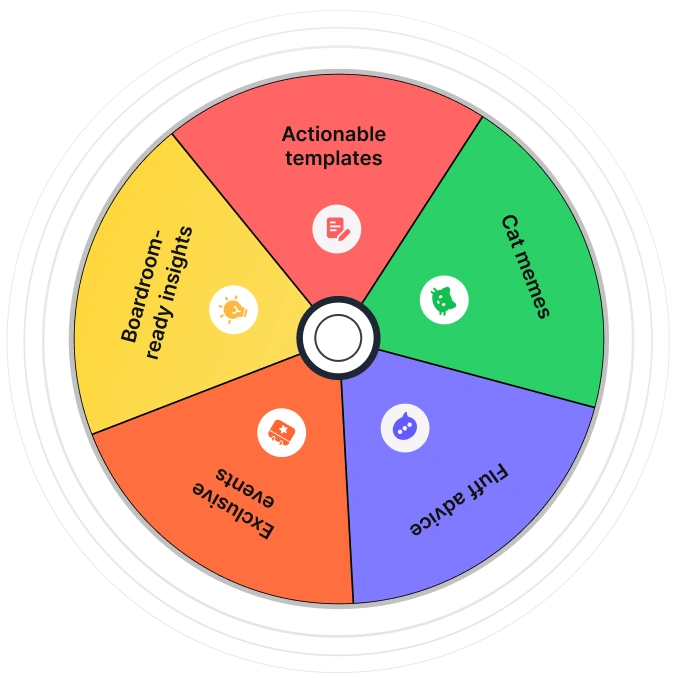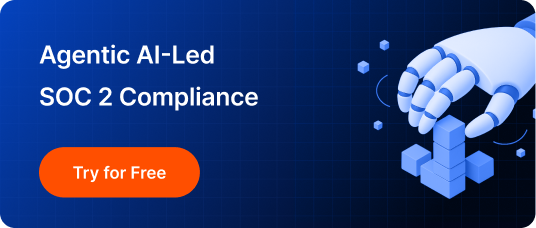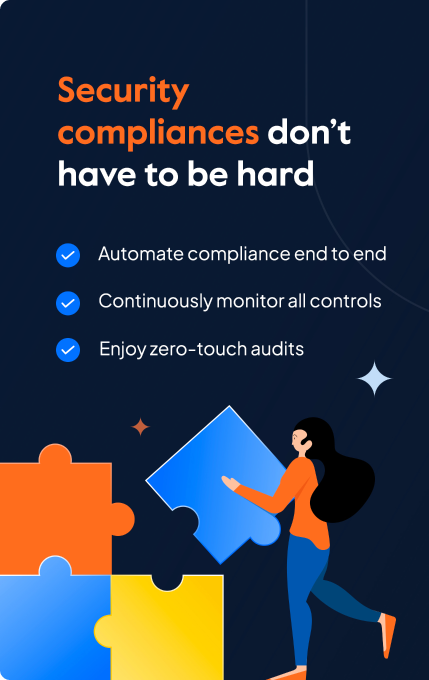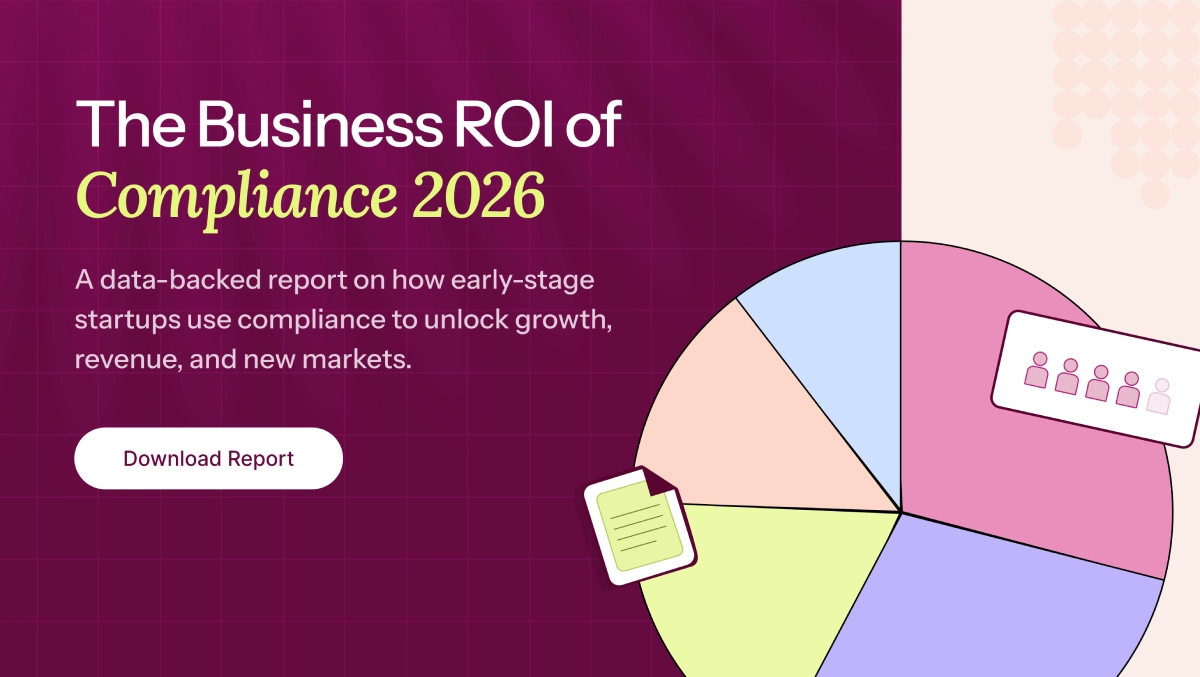A big ticket deal seems to be progressing well. The final demo went smoothly. The prospect seems eager to sign the deal, even giving you a verbal thumbs-up pending last-minute approvals. And then, out of left field, comes an email asking you to send over your SOC 2 report.
Panic sets in. Slack threads light up. And suddenly, the deal seems to slip from your grasp and aling with it a big chunk of your quarter’s pipeline.
For fast-growing startups, this is nothing short of a horror story. To avoid this outcome, it’s vital you understand what SOC 2 requires you to do, how it works, and how to adhere to these requirements before your customers ask for it.
This blog breaks down the essentials of SOC 2 requirements, including what auditors evaluate, the core requirements under each Trust Services Criteria, common pitfalls to avoid, and the typical timeframe for SOC 2, depending on your stage.
What is SOC 2 and what does it require?
SOC 2 is a popular compliance framework developed by the American Institute of Certified Public Accountants (AICPA). It defines how service organizations, especially SaaS and cloud providers, can securely manage customer data to protect the privacy and interests of their clients. A SOC 2 report provides independent assurance that a company’s systems and processes are designed to safeguard data, minimize risk, and maintain operational integrity.
SOC 2 audits are based on five Trust Services Criteria (TSC): Security, Availability, Confidentiality, Processing Integrity, and Privacy. These categories guide how a company must manage its systems, data, and operations to meet modern security expectations.
Unlike rigid frameworks like ISO 27001, SOC 2 is principle-based, meaning it doesn’t prescribe exact controls. Instead, it requires companies to implement internal practices that align with the five criteria and prove, with evidence, that those controls are in place and functioning. This flexibility makes SOC 2 a good framework that companies of all sizes and industries can adopt.
In simple terms, SOC 2 asks:
- Do you have the proper controls in place to secure customer data?
- Are you operating those controls reliably over time?
- Can you prove it with documentation and evidence?
Who does the SOC 2 requirements apply to?
SOC 2 requirements apply to any service organization that stores, processes, or transmits customer data in the cloud, especially companies offering B2B software or digital services. This includes:
- SaaS providers
- Cloud infrastructure platforms
- Data analytics services
- Managed service providers (MSPs)
If your business handles customer data and your customers expect assurance around how you secure that data, SOC 2 likely applies to you. In fact, many enterprise buyers now make SOC 2 a mandatory part of their vendor due diligence. Even if you’re a startup, pursuing SOC 2 early signals maturity, reduces sales friction, and builds trust with customers who care about security.
“You could be a small startup with just a couple of people, but if you are selling enterprise first, they are going to ask you for SOC 2 on day zero.”
— Girish Redekar, Co-Founder at Sprinto
Core SOC 2 requirements (Trust Services Criteria)
SOC 2 audits are built around five key areas called Trust Services Criteria (TSC). These are the categories under which your security and operational controls are evaluated. Every organization must include Security (also called the Common Criteria), while the others are optional, depending on the services you offer.
Here’s what each of them means, in simple terms:
1. Security
This is the foundation of every SOC 2 audit and applies to all organizations. It covers vital SOC 2 controls and measures that govern how you protect your systems and data from unauthorized access, system failures, and security breaches.
- Examples: Multi-factor authentication (MFA), role-based access controls, antivirus software, firewalls, and employee security training.
- Goal: The focus is on ensuring that only authorized individuals can access systems and data, and that threats are actively prevented and detected.
2. Availability
This TSC evaluates whether your systems are made available for operation and use as committed or agreed. It focuses on system uptime, infrastructure performance, and incident handling.
- Examples: Disaster recovery plans, real-time system monitoring, regular data backups, and load balancing.
- Goal: The goal is to minimize downtime and ensure customers can access your services without interruption.
3. Confidentiality
Confidentiality controls safeguard sensitive business or customer data from unauthorized access by users. It applies to data classified as confidential by law, regulation, or internal policy.
- Examples: Encryption at rest and in transit, access restriction based on roles, and secure file transmission.
- Goal: This ensures sensitive data is only shared with and accessible to the right people, reducing data exposure risk.
4. Processing Integrity
This criterion assesses whether your systems process data in a way that is complete, valid, accurate, and timely. It ensures that your software behaves as intended and doesn’t introduce errors.
- Examples: Automated validations, audit trails, process logging, and exception handling mechanisms.
- Goal: Guarantee accurate, complete, and timely data processing to support trustworthy outputs for critical services like billing, analytics, and transaction workflows.
5. Privacy
Privacy criteria focus on how your organization collects, uses, retains, discloses, and disposes of personal information. It must align with your privacy notice and applicable privacy laws.
- Examples: Consent management, opt-out workflows, data minimization, and secure deletion.
- Goal: The objective is to protect Personally Identifiable Information (PII) and ensure transparency and compliance with data protection standards.
SOC 2 documentation requirements
Having good security practices is not enough to pass a SOC 2 audit; what you need is proof. That’s where documentation comes into the picture. It shows auditors that your controls and processes are well-defined and consistently followed.
Here are the SOC 2 documents you’ll need:
1. Security policies
These are clear, written rules that govern how your company handles security. It includes policies on access control, data handling, incident response, and vendor management. Auditors check whether your actual operations align with these policies or not.
2. Procedures and SOPs
These are step-by-step guides for essential operational tasks like onboarding new hires, removing access for terminated employees, deploying code, and handling incidents. SOPs prove you have repeatable processes in place.
3. Risk assessments
These are periodic reports that outline threats to your systems and data, as well as the mitigation strategies you have implemented. Risk assessments show that you’re proactively identifying and addressing vulnerabilities.
4. Asset inventory and data classification
You’ll need a complete list of systems, tools, and devices used in your environment, along with a classification of data types (e.g., public, internal, confidential, restricted). This demonstrates to auditors that you understand what you’re securing.
5. Change management logs
Records of infrastructure and software changes, including code commits, pull requests, release notes, and approvals. These logs prove that changes are controlled and traceable.
6. Privacy documentation
Documents that describe how you collect, store, share, and delete customer data. Examples include privacy notices, data use agreements, opt-out policies, and PII handling procedures.
7. Vendor contracts and SLAs
Agreements with third parties must outline how they handle your data securely. This includes SLAs, NDAs, and data protection clauses. If a vendor fails to perform, it could put your compliance at risk as auditors want proof that you’re covered.
8. Management assertion
Management assertion is a mandatory part of every SOC 2 report. This document summarizes your systems, services, and controls. Think of it as a formal statement defining the organization’s current security framework. It helps auditors understand your environment before reviewing evidence.
Collectively, these documents build the foundation of your SOC 2 audit. They show you don’t just talk about security, you operationalize it, monitor it, and back it up with proof.
Want the complete list with examples? Read our full SOC 2 Documentation Guide.
SOC 2 security control requirements
SOC 2 security control requirements refer to the set of safeguards you put in place to protect systems and data from unauthorized access, misuse, or failure. These controls are what auditors review to determine whether your company is secure “by design” and “in practice.”
Here’s what it includes:
1. Logical access controls
These ensure only authorized people can access your systems. You can reduce the risk of unauthorized access by implementing Single Sign-On (SSO), Multi-Factor Authentication (MFA), and Role-Based Access Control (RBAC).
2. Encryption
Encryption protects data during transfer (TLS) and while stored (AES-256 encryption). For example, customer data sent over the internet should use HTTPS (TLS), and stored database files should be encrypted at rest.
3. Network & endpoint security
You need to ensure network and endpoint security with tools like VPNs, antivirus software, and Endpoint Detection and Response (EDR). This helps prevent malware, ransomware, and intrusion attempts.
4. Logging & monitoring
You must implement centralized logging and a Security Information and Event Management (SIEM) system to detect and respond to unusual activity. For instance, if a user logs in from two countries within minutes, that anomaly should trigger an alert.
5. Vulnerability management
Regularly scan systems for known vulnerabilities and patch them promptly. A structured patch management schedule and tracking system (e.g., Jira tickets) ensures you don’t miss critical security fixes.
6. Secure SDLC controls
Integrate secure coding practices into development workflows. This includes peer code reviews, automated testing, and CI/CD checks. For example, a pull request should only be merged after it passes security review and test suites.
Common SOC 2 requirements companies miss
One of the primary reasons why startups fail at SOC 2 audits is that they often overlook the basics. To ensure that this doesn’t happen to you, we have curated the most common pitfalls that you should avoid:
1. Skipping periodic access reviews
Granting access is easy. Taking it away is where companies miss out. If you’re not regularly reviewing who has access to what, you risk giving former employees or internal users privileges they no longer need. This is a major red flag for auditors.
2. Vendor assessments without risk scoring or documentation
Just having a vendor isn’t enough. You need to assess their security posture and document why you trust them with your data. Without vendor risk assessments and signed agreements, your audit could be derailed.
3. Untracked change management
Code gets pushed. Infrastructure gets updated. But if those changes aren’t logged, reviewed, and approved, auditors will question your internal controls. Every change should leave a trace via a ticket, a commit, or an approval log.
4. Inconsistent onboarding/offboarding
Incomplete offboarding is a minefield that very often causes audit failures. Orphaned accounts are a sign that security hygiene isn’t being taken seriously. When employees join or leave, their access must be handled consistently and swiftly.
Treat these as non-negotiables. SOC 2 goes beyond technical controls; it’s about discipline and operational maturity.
— Rajeev Kumar, Co-founder, Neurosynaptic
SOC 2 type 1 vs type 2 requirements
Understanding the difference between SOC 2 type 1 and SOC 2 type 2 audits is critical when planning your SOC 2 journey. Each serves a different purpose and requires a different level of effort. Here’s a breakdown:
What is SOC 2 type 1?
A SOC 2 Type 1 audit evaluates whether your organization has the right controls in place at a specific moment in time. It’s like a snapshot of your security posture on a given day. The goal is to verify that your systems, policies, and procedures are properly designed and documented. This type of audit does not assess how well those controls function over time—only that they exist and are ready for use. Type 1 is often the starting point for early-stage companies or those undergoing SOC 2 for the first time, as it offers a quicker path to initial assurance.
What is SOC 2 type 2?
SOC 2 Type 2 audits go a step further by evaluating not just the existence of controls, but also their effectiveness over a continuous monitoring period—typically 3, 6, or 12 months. Instead of a snapshot, it’s more like a highlight reel, showing whether your controls consistently worked as intended throughout the audit window. This type of audit requires disciplined execution and solid evidence collection. It’s best suited for mature organizations that want to signal operational rigor and long-term reliability to enterprise buyers and partners.
Key differences at a glance
| Aspect | Type 1 | Type 2 |
|---|---|---|
| Timeframe | Point in time | Over a defined period (3-12 months) |
| Focus | Control design | Control effectiveness |
| Effort required | Moderate | High (evidence collection over time) |
| Audit readiness | Faster | Takes longer |
| Buyer perception | Entry-level assurance | Strong signal of operational maturity |
How long do you need to collect evidence for Type 2?
For a Type 2 audit, auditors expect to see consistent, reliable evidence over a defined audit period, typically 3, 6, or 12 months. The length you choose impacts the level of assurance your report provides. Most companies new to SOC 2 start with a 3-month period and graduate to longer windows in future audits.
How do audit timelines affect requirements?
Your audit period directly influences how your controls must operate. If you commit to monthly access reviews, for example, you’ll need to show that they were completed every month during the audit window. Missing a control frequency, even once, can result in an audit exception. That’s why timing, monitoring, and evidence hygiene matter as much as the controls themselves.
Which one should you choose?
- Start with Type 1 if you’re getting your first audit and want to show progress fast.
- Progress to Type 2 once your controls are stable and you can sustain ongoing operations.
- Enterprise buyers often require a Type 2 report to approve a vendor, as it’s considered the real benchmark.
In summary, Type 1 tells your story at the starting line. Type 2 shows that you can run the race, finish strong, and keep doing it quarter after quarter.
How long does it take to meet SOC 2 requirements
The time it takes to become SOC 2 compliant depends on your company’s size, complexity, and current security posture. To give you a fair idea, here’s the table that shows how long you can expect it to take based on your stage:
Typical SOC 2 readiness timelines
| Company Stage | Estimated Time to Readiness | Why It Takes This Long |
|---|---|---|
| Early-stage startups | 4–6 months | Starting from scratch: building controls, drafting policies, implementing tools, and educating teams. |
| Mid-sized teams | 2–4 months | Some controls already exist; need documentation, monitoring setup, and audit prep. |
| Enterprises with GRC | 1–2 months | Mature processes and tools in place; mainly focused on evidence collection and gap remediation. |
What makes SOC 2 time-consuming?
SOC 2 is all about proving good practices through rigorous evidence and well-documented processes. Here are the common time sinks that slow companies down:
- Drafting and aligning policies with Trust Service Criteria
- Implementing missing technical and procedural controls
- Setting up logging, monitoring, and alerts
- Collecting and organizing evidence for the audit
- Coordinating across teams and tools
Without a dedicated system, companies spend hundreds of hours navigating spreadsheets, gathering documents, and chasing down stakeholders.
Sprinto helps you meet SOC 2 requirements faster
SOC 2 can feel overwhelming, especially for lean teams balancing product, sales, and security. Without automation, you are stuck burning hundreds of hours chasing evidence, managing spreadsheets, and prepping for audits. That operational drag slows down the very momentum SOC 2 is supposed to unlock.
Sprinto changes that with its AI-first approach to compliance. It does not just automate checklists. It actively monitors your controls, flags policy drift, detects evidence gaps, and streamlines vendor due diligence. It transforms SOC 2 from a one-time project into a continuous, self-correcting system that keeps your team audit-ready with minimal lift.
Here’s how Sprinto AI helps you move fast and stay secure:
- Pre-mapped controls: Leverage an auditor-grade control library pre-aligned with SOC 2 Trust Services Criteria, ready to tailor and activate.
- AI-generated policy templates: Access customizable, cloud-ready policies created and updated by Sprinto AI to match your specific environment.
- Autonomous evidence collection: Sprinto offers 250+ integrations including tools like AWS, GitHub, and Okta for real-time, AI-powered evidence collection—no screenshots, no spreadsheets.
- Proactive monitoring: Sprinto AI continuously tracks your compliance posture, flags drift, and alerts you before audit issues arise.
- AI agents for repetitive tasks: Offload manual GRC work like evidence gap detection, vendor risk reviews, and control testing to intelligent AI agents.
- Instant framework onboarding: Add new frameworks or custom standards in minutes using Sprinto AI’s intelligent auto-mapping engine.
- Democratized compliance knowledge: Use Ask AI and browser extensions to bring instant, contextual answers to audits, questionnaires, and policy queries.
- Audit-ready views: Centralize documentation, evidence, and control statuses in one clean dashboard built for auditors and internal reviews.
— Rafael Urgiles, Chief IT-S Consultant, Kin Analytics
Ready to meet SOC 2 requirements? Speak to our experts today.
FAQs
1. What are the mandatory SOC 2 requirements?
The Security (Common Criteria) controls are mandatory for all SOC 2 audits. You can optionally include Availability, Confidentiality, Processing Integrity, and Privacy based on your service commitments.
2. What technical controls are required for SOC 2?
Logical access, encryption, vulnerability management, logging, monitoring, and secure SDLC practices are key technical controls.
3. Can SOC 2 be achieved without automation?
It’s possible, but not scalable. Without automation, evidence collection becomes error-prone and time-consuming.
4. How often do SOC 2 requirements change?
The AICPA updates Trust Services Criteria periodically. It’s critical to stay aligned with the latest version and ensure controls evolve with your tech stack.
5. How much does SOC 2 cost?
SOC 2 costs typically range from $5,000 to $50,000, depending on your company’s size, scope, and audit readiness. Early-stage teams often spend more on preparation and tooling, while mature organizations with existing controls incur lower costs.
Gowsika
Gowsika is an avid reader and storyteller who untangles the knotty world of compliance and cybersecurity with a dash of charming wit! While she’s not decoding cryptic compliance jargon, she’s oceanside, melody in ears, pondering life’s big (and small) questions. Your guide through cyber jungles, with a serene soul and a sharp pen!
Explore more SOC 2 articles
SOC 2 Compliance Overview
SOC 2 Preparation and Documentation
SOC 2 Audit and
Reporting
SOC 2 Differences and Similarities
SOC 2 Updates & Management
SOC 2 Industry-Specific Applications
research & insights curated to help you earn a seat at the table.











